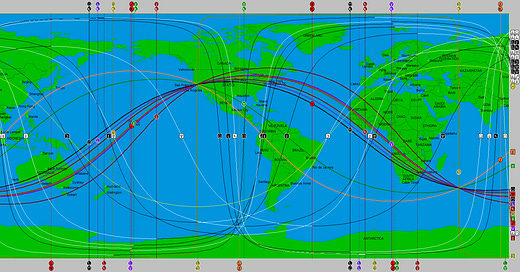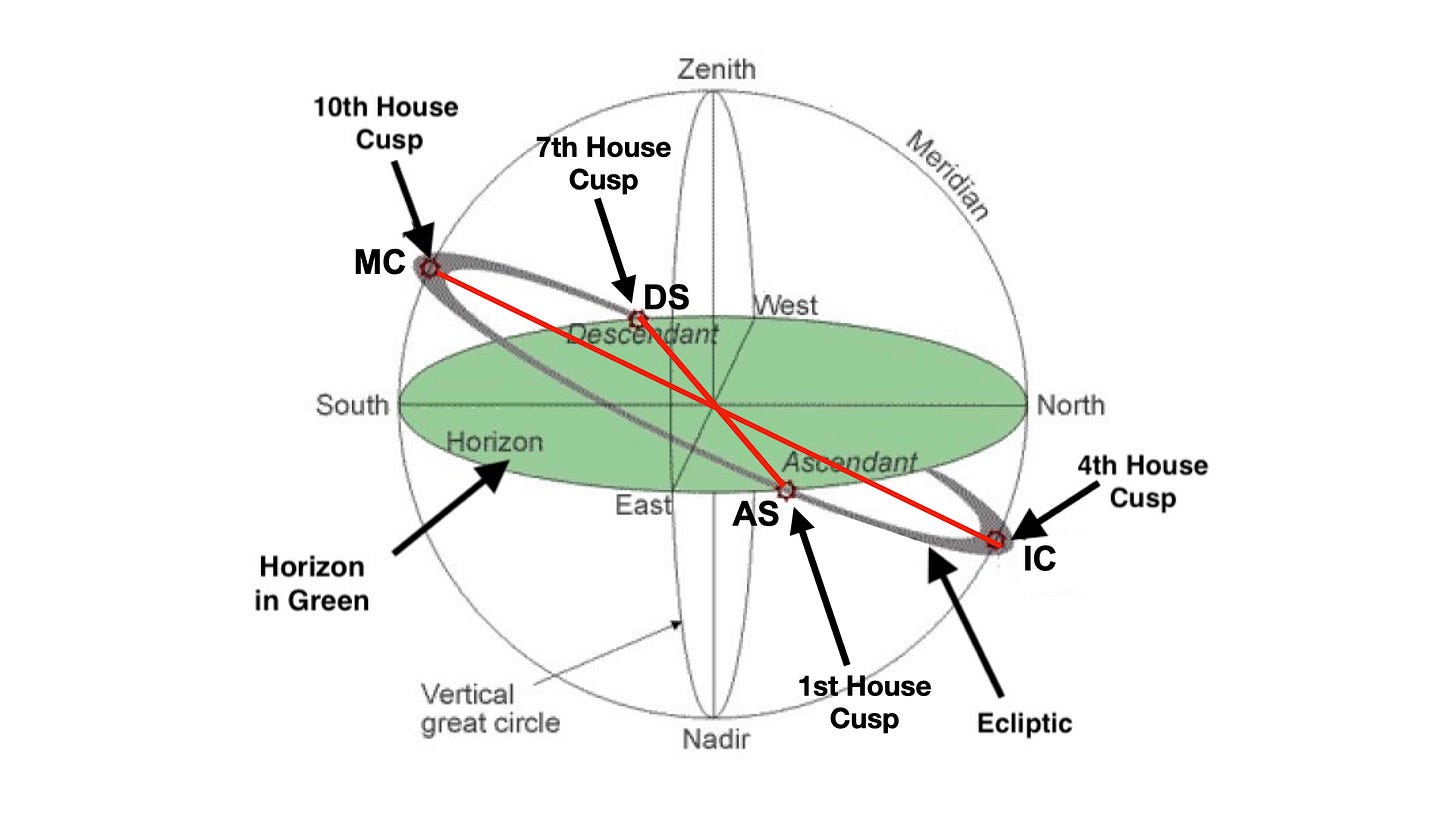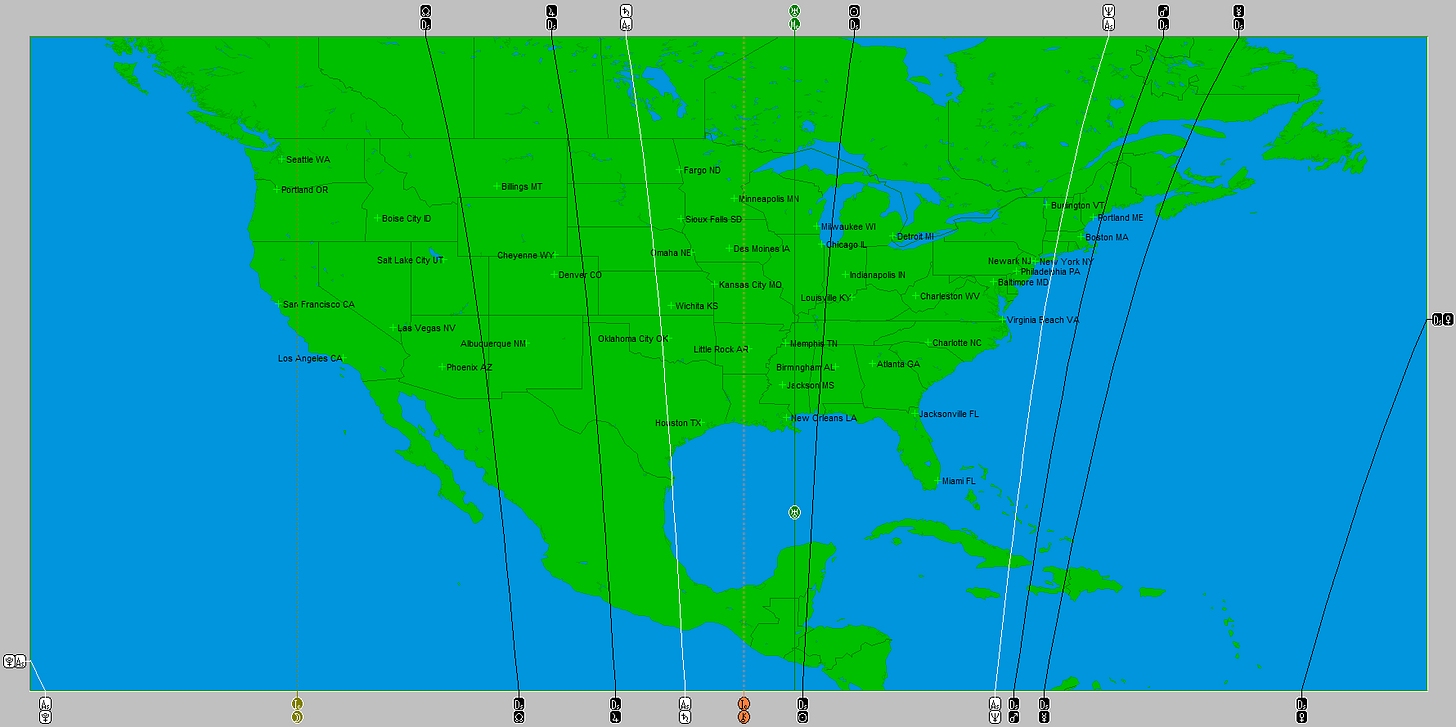There is a keen interest in astrocartography these days. People want to know the best place to attend university, secure that dream job, find happiness, or become more socially engaged. Often, people want a definitive answer, like “Rome is your happy place” or “moving to Honolulu will land you that perfect job”. However, like everything astrological, it isn’t that simple. But! It’s true that people intuitively move to their natal chart planetary lines.
Years ago, when I first heard of astrocartography, I was skeptical, to say the least. It was a bit too far-out there for me. Planetary lines that go all the way around the world? Really?! But as I pride myself on having an open mind, I did a little research project. Then, I began taking vacation road trips along my lines, to visit places that looked potentially inviting. More on my research in a minute.
For those of you who have not heard of astrocartography, it is a technique that projects planetary lines from the birthplace to the position of the planets in the sky at birth, and then, continues those lines in that direction around the world. The technique was pioneered by Jim Lewis in his book, The Psychology of Astro*Carto*Graphy, in which he explains the math and science of it. You can read a free copy of his 1997 edition here. Later editions are available on Amazon. Lewis had self-published his work much earlier in the 1970s, but I don’t know when he first came up with his theories.
Lewis promoted two techniques based on the planetary positions of the natal chart projected around the world. The first technique moves the natal planets to the closest angle house cusps (1st, 4th, 7th, and 10th house cusps). The angle house cusps are intersecting points of the ecliptic and horizon planes, and the ecliptic and meridian planes. We label them the Ascendant (AS), Descendant (DS), Midheaven (MC) and Imum Coeli (IC). The astrological cross is in red. The ecliptic is the plane on which the Sun traverses the sky from the viewpoint of earth. All the constellations and planets move along the ecliptic plane.
Since the angles are the most sensitive points in the chart representing a person’s basic human needs, there is logic to it. These Angle Lines with the associated planets are noted on the map below. On the map below, you can see two white lines: both Saturn and Neptune are placed with the AS line because they are in the 1st and 2nd houses in the natal chart, closest to the AS angle.
I could map any part of the world, and single out a state or province for a more detailed look. I can add cities to the maps. Having many digital options makes the exploration fun.
The second technique illustrates Local Space Lines. These lines are projected from the place of birth in the direction of the planet in the sky and then around the world without moving planets to the angles. Here you can see I was born in California. The image below shows only the local space lines. I added the projected house lines too.
There’s one other consideration we can interpret, called paran lines. These lines are rising and setting, above and below, the place we are considering, and also have influence.
My Research
My first bit of research was to see if I myself had been intuitively living on my lines. I had moved a lot during my adult years since graduating from high school in 1969. By 1998, when I first became interested in the technique, I had lived in four states and twelve cities. I was shocked to see that I had gravitated to a line every time I moved without having any knowledge of astrocartography. That got my attention. Then I checked some family member’s charts. My parents were born and raised in the same town and never left, but my siblings did. My siblings and I were raised on the West Coast. My brother went to a university in Kansas before moving back home to stay. Did he go to school on a line? YES! My sister got married right out of high school and moved to her husband’s hometown in Illinois. Did she move to one of her lines? YES! She did! Now, I’m getting a little “wierded out”.
Next, I went through my astrology client list - people who I knew personally and kept track of where they had moved. I gathered 100 charts and looked at all of their astro-maps. The results were startling. All but three people were solidly on a line. I had to accept it. People do, in fact, intuitively gravitate toward their lines!
My travels along my lines taught me a thing or two. Not ALL places on our lines are going to be good for us, even when we theoretically think they ought to be. We can look at our maps and see potential good places. We can theoretically look at the MC lines for places good for our careers, or our DS lines for places where we might have a more robust social life. But then, we have to go there to see how it feels, because within the two-hundred-or-so mile “radius of effect”, there will be several cities or towns, and one could feel great while another might not.
Authors writing about astro-location use the basic interpretations we often see about the planets. For instance, if you are seeking spiritual enlightenment or a peaceful place to retire, look to your Neptune lines. If you are focused on career development, look at your Saturn line. If you want to rev up your social life, look to your Jupiter line. Looking for love, follow the Venus line. But again, it really isn’t that simple. Why? Because we all have those planets in different signs and houses, and they relate to the other planets a certain way unique to us. Venus doesn’t always represent love in our natal charts. It can represent what we love doing or indicate an artistic career. It can symbolize what we value most in life. Not everyone relates to any one planet or sign the same way. We are unique individuals and there is no set interpretation that works for everyone.
That is also true when interpreting an astro-map. We can’t just look at those lines and instantly know what is going to suit our purposes well. We need to have studied our natal charts so that we know how each planet is functioning and how we are using them. Then we analyze what we need now in relationship to a move - and then - associate it with the planetary line that might aid us in our goals. We would consider the paran line influences too. We then have to go there to see if the place feels right - just like you’d interview for a job to see not only if they like you, but if you like the boss and the people you’d work with? Is it truly a good fit?
As we grow and mature, we can feel very differently about a place. On one of my trips, I was smitten with a place where my angle Jupiter line crossed my Jupiter local space line. It was interesting because I found a community of people who migrated to the United States from Ukraine - where my father’s ancestors came from. They are called “Black Sea Germans”. This group has their own ancestry website, and my family is listed! Unexpectedly, there they were, a fairly large community of them. I seemed to meet people easily who were happy to engage with me. I had a good time listening to their stories, which sounded a lot like my family’s stories. I even looked for work while I was there and applied to teach some classes at the community college. Despite my efforts, no jobs came to me and I gave up on the idea of living there. However, I couldn’t let go of the exhilarating first visit, so I went back eight years later to see if I still might want to move there. This time, it was an entirely different experience. I didn’t meet people easily, and didn’t connect so deeply when I did. The excitement and joy of the first visit seemed to be missing. I left a bit disappointed. I realized that it was one vacation’s highlight, and would remain just that.
If you are using astro-location to decide upon a schooling experience, my advice is to pick the school that will give you the best education in the field of your study. Get to know the professors, who you want to study with. I’d put the location second on my consideration list. If you’ve picked the best schools and can’t decide between them, then place can be considered, based on other priorities and needs.
I use astrocartography in my practice, and sometimes it is helpful in assisting people in their decision-making process. But, I incorporate other tools with it, and, I ask the client a lot of questions in regard to their needs, and I only use it after a thorough reading of the natal chart, so I know what questions I need to ask. I also use a relocation chart with astrocartography. You can erect a relocation chart by using the birthdate and time, but the new location instead of the birthplace. The planets will still be in the same signs and in the same relationship with one another, but possibly in different houses. It will give some hints to what the new influences might be in that location. If you are moving north or south from the birthplace, there won’t be much change from the birth chart. If moving east or west, there will be. The further east or west you move, the bigger the changes.
Like all astrological techniques, astrocartography can only speak in terms of potentials. Interpretations are as good as the astrologer, and even the best, can be wrong at times. So, my message today is - seeking astrological guidance based on astrocartography can be very helpful, but realize that you know yourself better than anyone, and that you have the ability to intuitively pick the right place at the right time. And if using astrocartography, be sure to visit any place that has potential before moving there. Trust how you feel when you are there. And know that you may not always be in love with a place forever. Some of us change a lot during our lifetime. Our needs change. Some people don’t change so much and stay in one place. They might need stability and familiarity in this lifetime. We’re all different.







I use Solar Fire. You can get it here - https://alabe.com/solarfireV9.html
Solar Fire software from Astrolabe.
https://alabe.com/solarfireV9.html